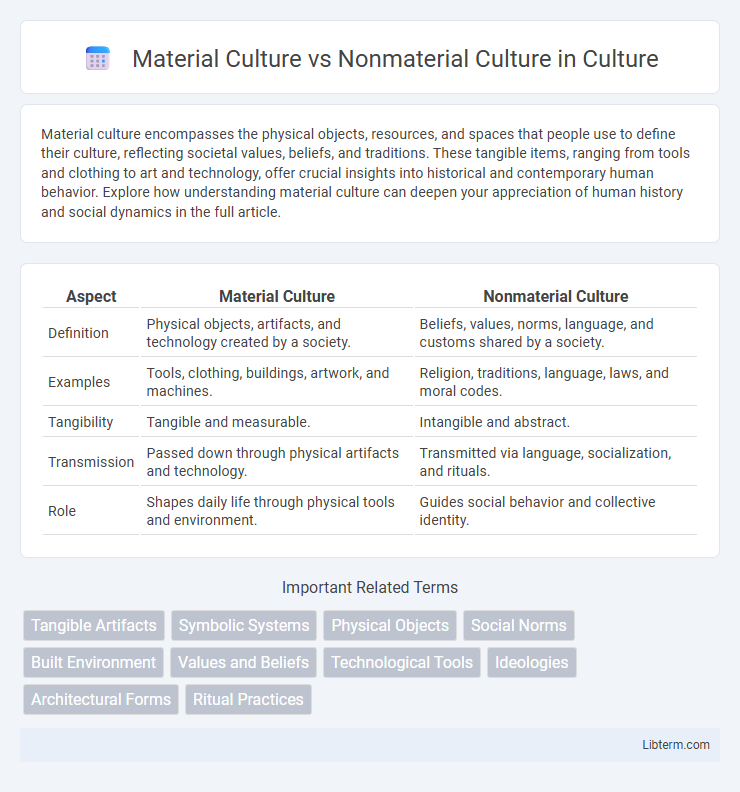Material culture encompasses the physical objects, resources, and spaces that people use to define their culture, reflecting societal values, beliefs, and traditions. These tangible items, ranging from tools and clothing to art and technology, offer crucial insights into historical and contemporary human behavior. Explore how understanding material culture can deepen your appreciation of human history and social dynamics in the full article.
Table of Comparison
| Aspect | Material Culture | Nonmaterial Culture |
|---|---|---|
| Definition | Physical objects, artifacts, and technology created by a society. | Beliefs, values, norms, language, and customs shared by a society. |
| Examples | Tools, clothing, buildings, artwork, and machines. | Religion, traditions, language, laws, and moral codes. |
| Tangibility | Tangible and measurable. | Intangible and abstract. |
| Transmission | Passed down through physical artifacts and technology. | Transmitted via language, socialization, and rituals. |
| Role | Shapes daily life through physical tools and environment. | Guides social behavior and collective identity. |
Defining Material Culture
Material culture encompasses tangible objects and physical artifacts created or used by a society, such as tools, clothing, buildings, and technology. These items reflect the values, beliefs, and technological advancements of a culture, serving as concrete evidence of human activity and social organization. Understanding material culture is essential for analyzing how societies interact with their environment and preserve their heritage through physical remains.
Understanding Nonmaterial Culture
Nonmaterial culture encompasses intangible elements such as beliefs, values, customs, language, and traditions that shape a society's identity and social behavior. It influences how individuals interpret their experiences and interact within their cultural context, guiding norms and moral codes beyond physical artifacts. Understanding nonmaterial culture is essential for comprehending the underlying framework that drives material culture and societal cohesion.
Key Differences Between Material and Nonmaterial Culture
Material culture consists of tangible objects like tools, clothing, and buildings that reflect a society's technological advancements and lifestyle. Nonmaterial culture encompasses intangible elements such as beliefs, values, norms, language, and customs that shape social behavior and identity. The key differences lie in physicality--material culture is concrete and observable, while nonmaterial culture is abstract and expressed through social practices.
Examples of Material Culture in Everyday Life
Material culture encompasses tangible objects created and used by people, such as clothing, tools, buildings, and technology like smartphones and vehicles, reflecting societal values and technological advances. Everyday examples include household items like furniture, kitchen utensils, and electronic devices, which facilitate daily activities and signify cultural identity. These physical artifacts contrast with nonmaterial culture, which includes beliefs, norms, language, and customs that shape social interactions and cultural meaning.
Nonmaterial Culture: Language, Beliefs, and Values
Nonmaterial culture encompasses the intangible aspects of society such as language, beliefs, and values that shape social behavior and identity. Language serves as the primary medium for communication and the transmission of cultural knowledge, while beliefs provide frameworks for understanding the world and guiding actions. Core values influence societal norms and ethical standards, reinforcing social cohesion and collective meaning within a community.
The Impact of Material Culture on Society
Material culture, consisting of physical objects like tools, clothing, and technology, significantly shapes societal behavior by influencing communication, social norms, and economic practices. The proliferation of smartphones and digital devices has transformed interaction patterns, creating new cultural norms around connectivity and information access. This tangible aspect of culture drives innovation, shapes identity, and affects social stratification within communities.
How Nonmaterial Culture Shapes Social Norms
Nonmaterial culture, including beliefs, values, customs, and language, fundamentally shapes social norms by guiding individual behavior and defining acceptable conduct within a society. These intangible elements influence social institutions and interactions, creating a framework for social order and cohesion. Cultural values embedded in nonmaterial culture establish norms that regulate roles, responsibilities, and moral expectations across communities.
Interactions Between Material and Nonmaterial Culture
Material culture, consisting of tangible objects like tools, clothing, and architecture, shapes and is shaped by nonmaterial culture, which includes beliefs, values, and norms. Interactions between these cultures manifest as material artifacts reflecting societal values, such as religious symbols or technological innovations inspired by cultural beliefs. Changes in nonmaterial culture often drive the modification or creation of new material culture, illustrating a dynamic reciprocity essential to cultural evolution.
Cultural Change: Material vs Nonmaterial Influences
Material culture consists of physical objects and artifacts that shape societal behavior, while nonmaterial culture encompasses beliefs, values, and norms influencing social dynamics. Cultural change often originates from innovations in material culture, such as technology or infrastructure, which subsequently alter nonmaterial elements like ideologies and social practices. Conversely, shifts in nonmaterial culture, including changing attitudes or religious beliefs, can drive modifications in material culture, reflecting a reciprocal relationship in cultural evolution.
The Importance of Balancing Material and Nonmaterial Culture
Balancing material culture, such as tools, technology, and artifacts, with nonmaterial culture, including beliefs, values, and customs, is essential for a harmonious society. Overemphasis on material culture can lead to consumerism and neglect of cultural identity, while focusing solely on nonmaterial aspects may hinder technological advancement. Integrating both ensures cultural continuity, social cohesion, and sustainable development.
Material Culture Infographic

 libterm.com
libterm.com